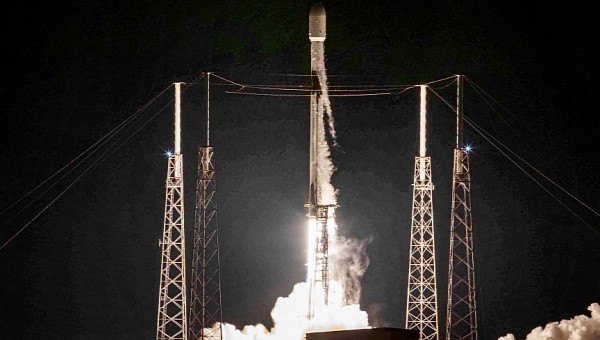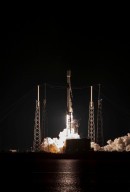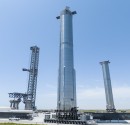Regarding SpaceX's spectacular reusable Falcon 9 booster rocket, we've become used to their launches as almost a routine part of the news cycle. Not every satellite launch is worthy of coverage, but one that sets the record for heaviest payload hauled to Low Earth Orbit sure is.
Following a ten-minute delay, a Falcon 9 laden with upwards of 17.4 metric tons (19.4 tons) of Starlink satellites, this fully-loaded rocket lifted off from Cape Canaveral Space Force Station in Florida at approximately 4:30 in the morning. The first stage in this particular falcon nine was a veteran of nine separate launches before this morning, including two human-crewed transfers to and from the International Space Station.
The payload fairing meant to house the rocket's precious cargo is itself a veteran of five different Falcon 9 launches. This didn't stop the first stage, now an old man in rocket terms, from sticking a landing onto a SpaceX recovery drone ship ready to be re-used again. Just under an hour after liftoff, the Falcon 9 released its payload of Starlink satellites, aiding greatly in the expansion of Starlink satellite internet services in the process.
In excess of 3,400 Starlink satellites currently orbit the Earth. But the novel gen-II variants on board this most recent Falcon 9 launch are even more special. Capable of delivering higher internet bandwidth per individual satellite with benefits like direct-to-smartphone access, Starlink Gen-II is a design built to meet the skyrocketing demand for SpaceX's popular internet service.
In parts of the world where high-speed fiberoptic internet is unfortunately not a part of the local ecosystem, Starlink is most people's only hope of keeping up with an increasingly more technology-dependant world. For Elon Musk's plan to launch a further 30,000 microsatellites before Starlink's declared complete, the Falcon 9 launch system has to continue to hold up.
At the launch pace currently on schedule, SpaceX should easily break its yearly launch total set in 2022 of 61. Could they really reach 100 launches in a single year? It's not entirely an impossibility. While SpaceX busies themselves developing Starship hardware in time to launch with the Artemis III Moon landing, these numerous Falcon 9 launches for companies across the globe will ensure there's enough funding to go around.
As for SpaceX in general, it's quite apparent 2023 is the year that could make or break the company going forward. As the most technologically sound Elon Musk operation, there's an expectation of success spurred on by lucrative government contracts, which isn't necessarily present with Tesla or the Boring Company.
There can and probably will be massive consequences for SpaceX if they're unable to meet the deadline for Artemis III, scheduled for 2024. So keep those Starlinks launching, Mr. Musk, your ambitions of going to Mars depends on it.
The payload fairing meant to house the rocket's precious cargo is itself a veteran of five different Falcon 9 launches. This didn't stop the first stage, now an old man in rocket terms, from sticking a landing onto a SpaceX recovery drone ship ready to be re-used again. Just under an hour after liftoff, the Falcon 9 released its payload of Starlink satellites, aiding greatly in the expansion of Starlink satellite internet services in the process.
In excess of 3,400 Starlink satellites currently orbit the Earth. But the novel gen-II variants on board this most recent Falcon 9 launch are even more special. Capable of delivering higher internet bandwidth per individual satellite with benefits like direct-to-smartphone access, Starlink Gen-II is a design built to meet the skyrocketing demand for SpaceX's popular internet service.
In parts of the world where high-speed fiberoptic internet is unfortunately not a part of the local ecosystem, Starlink is most people's only hope of keeping up with an increasingly more technology-dependant world. For Elon Musk's plan to launch a further 30,000 microsatellites before Starlink's declared complete, the Falcon 9 launch system has to continue to hold up.
At the launch pace currently on schedule, SpaceX should easily break its yearly launch total set in 2022 of 61. Could they really reach 100 launches in a single year? It's not entirely an impossibility. While SpaceX busies themselves developing Starship hardware in time to launch with the Artemis III Moon landing, these numerous Falcon 9 launches for companies across the globe will ensure there's enough funding to go around.
As for SpaceX in general, it's quite apparent 2023 is the year that could make or break the company going forward. As the most technologically sound Elon Musk operation, there's an expectation of success spurred on by lucrative government contracts, which isn't necessarily present with Tesla or the Boring Company.
There can and probably will be massive consequences for SpaceX if they're unable to meet the deadline for Artemis III, scheduled for 2024. So keep those Starlinks launching, Mr. Musk, your ambitions of going to Mars depends on it.












